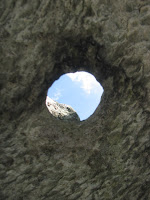Like the nearby Little Lost Cove Cliffs, these soaring faces are a
 part of Big Lost Cove Ridge and Headquarters Mountain. There are a number of impressive related peaks nearby rising up toward the spine on which the Blue Ridge Parkway winds, and then onward to the king peak of the Blue Ridge, Grandfather Mountain/Tanawha.
part of Big Lost Cove Ridge and Headquarters Mountain. There are a number of impressive related peaks nearby rising up toward the spine on which the Blue Ridge Parkway winds, and then onward to the king peak of the Blue Ridge, Grandfather Mountain/Tanawha.
Occasionally in my travels I will happen upon a place that is so
 beautiful and so awe-inspiring that I don't want to leave it. Logic will tell me that I need to go, that others are waiting, that it's getting dark, that people who love me are waiting for my return; but just the same I can't seem to tear myself away. Big Lost Cove Cliffs was just such an experience for me.
beautiful and so awe-inspiring that I don't want to leave it. Logic will tell me that I need to go, that others are waiting, that it's getting dark, that people who love me are waiting for my return; but just the same I can't seem to tear myself away. Big Lost Cove Cliffs was just such an experience for me.
The hike to the cliffs is interesting, passing through a really weird type of forest that I'd never encountered: a mix of chestnut oaks and hemlocks. Of course the hemlocks are all dead or nearly so. But the oaks are healthy enough and the woods along Big Lost Cove Ridge are strangely open. Even in the midst of green summer one can stand on the trail and peer through the woods for great distances. I would assume that these woods were logged completely to the ground within the last seventy to eighty years, so the soil and weather/moisture conditions must be ideal to produce such a healthy and impressive forest in so short a time.
 The southern Appalachians in general are a prime example of how well Mother Earth heals herself if left alone. But this area is an exceptional example. The entire region around Big Lost Cove Ridge was once logged down to the dirt; and it had a thriving community with homes, stores, textile mills, and lumber mills. But in 1940 a great flood swept
The southern Appalachians in general are a prime example of how well Mother Earth heals herself if left alone. But this area is an exceptional example. The entire region around Big Lost Cove Ridge was once logged down to the dirt; and it had a thriving community with homes, stores, textile mills, and lumber mills. But in 1940 a great flood swept  through the then-nearest town (Mortimer) wiping away the mills. The town never recovered and it's now only a memory. These days you merely spy a few shattered walls standing in the woods, or stumble upon cracked foundations where once people lived and worked.
through the then-nearest town (Mortimer) wiping away the mills. The town never recovered and it's now only a memory. These days you merely spy a few shattered walls standing in the woods, or stumble upon cracked foundations where once people lived and worked.
The hike to Big Lost Cove Cliffs is a relatively easy one. From the trailhead along Forest Service Road 464, the trail follows an old logging road bed. It passes through those previously mentioned oak/hemlock forests. In spring and summer there are lots of mountain laurel, rhododendron, and azaleas in bloom. The guidebooks and maps give the trail distance from the road to the cliffs as one and one half miles. However, after having hiked it, I feel the distance is somewhat longer--perhaps as much as two miles.
The trail is an easy one, traversing the ridge line with very little gain or loss in elevation. After about a mile, however, the trail passes by a rock wall that looks ideal for bouldering and aid
 climbing. From this point the
climbing. From this point the  trail does lose a bit of elevation. Suddenly, one emerges from the forest at the top of Big Lost Cove Cliffs. The views are amazing. I'd thought that Little Lost Cove Cliffs had a wonderful grandstand for viewing Tanawha, but this one is even better, being several miles nearer the huge peak.
trail does lose a bit of elevation. Suddenly, one emerges from the forest at the top of Big Lost Cove Cliffs. The views are amazing. I'd thought that Little Lost Cove Cliffs had a wonderful grandstand for viewing Tanawha, but this one is even better, being several miles nearer the huge peak.
The cliffs plunge away impressively. Some of them for several hundred feet. The cliff tops have been colonized by Table mountain pines which look thick and stunted and ancient. The rock is pale and glowing in the sunlight. Peregrine falcons nest in the cliff and I heard their singular screech on the high winds that buffeted the tops.
It's a hard place to leave. It's one of the most beautiful spots I've visited in many years. I'll go back as soon as I can.

No comments:
Post a Comment